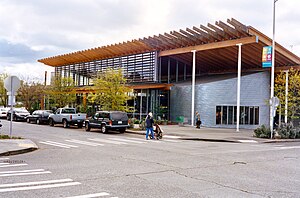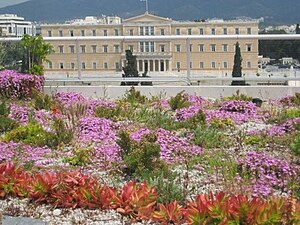Art and Architecture/ART102/Green architecture
In the last decade, there has emerged a strong interest in developing green architecture - designs that incorporate ecologically and environmentally sustainable practices in site preparation, materials, energy use and waste systems. Some are simple: buildings oriented to the south or west help with passive solar heating. Others are more complex: Solar voltaic cells on the roof to generate power to the building. Green roofs are made of sod and other organic material and act as a cooling agent and recycle rainwater too. In addition, technological innovations in lighting, heating and cooling systems have made them more efficient.
A branch of the Seattle Public Library uses green design. A glass curtain wall on the north side makes use of natural lighting. Overhanging wooden roof beams shades harsh light. The whole structure is nestled under a green roof of sod and over 18,000 low water use plants. Seven skylights on the roof provide more natural lighting.
And the California Academy of Sciences building in San Francisco harbors a living roof. Click on the hyperlink to view a short video and explore how it works.
The Jean Marie Tjibaou Cultural Center on the island of New Caledonia in the South Pacific captures the prevailing winds in sail-like structures that disperse it to the buildings interior as passive ventilation. Architect Renzo Piano's design is influenced by the indigenous tribal culture of the island.
The biggest human impact on the environment is in the development of our urban landscapes. Buildings and transportation routes are the most prominent (Marshall McLuhan declared “the road is our major architectural form”). Buildings serve different roles in our lives; shelter, education, work, entertainment and travel all use different building designs.
View architect Maya Lin’s discussion of transforming a park in Michigan.
Consider the following:
- What is a ‘good’ urban design? What is a ‘bad’ one?
- Do you prefer hard-edged designs or others that use more organic components? Explain your choice.
- What about the use of ‘green’ technologies? How do they enter into your ideas of good urban design?
Answer at least one of these questions in the course feed.
Note: Your comment will be displayed in the course feed.

